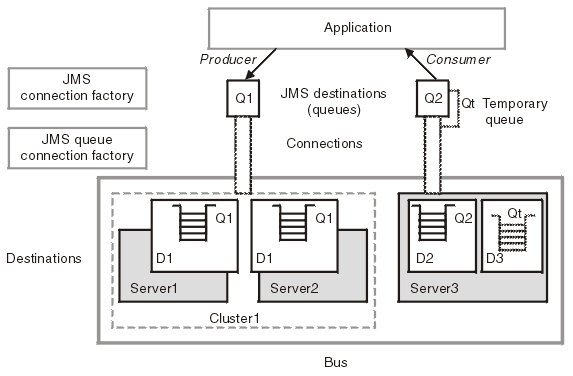Network Deployment (Distributed operating systems), v8.0 > Applications > Messaging resources > Default messaging
JMS queue resources and service integration
JMS queue resources (queues and queue connection factories) are provided by the default messaging provider for JMS point-to-point messaging and supported by a service integration bus.
The following figure shows a bus with two members, a server and cluster. The two members each have a JMS queue. An application sends messages to one JMS queue and retrieves messages from the other JMS queue. There are queue destinations on a service integration bus and the JMS connection factories. These objects are described in detail below.
Figure 1. JMS point-to-point messaging and the default messaging provider

- JMS queue
- The term "JMS queue" is used to refer to the JMS destination (an instance of javax.jms.Queue) that applications interact with, and that an administrator configures as a JMS resource of the default messaging provider.
An administrator can define a JMS queue, an administrative object that encapsulates the name of a queue destination on a service integration bus. Applications can obtain the JMS queue by looking its name up in the JNDI namespace.
Applications that uses JMS point-to-point messaging act as producers or consumers of messages with JMS queues, and have no need to know about the service integration resources that support JMS queues.
- Queue
- The term "queue" is used as an abbreviation for "queue destination", and refers to a service integration bus destination configured for point-to-point messaging.
The administrator assigns the queue to only one member (an application server or server cluster) of the bus. The messaging engine in the bus member hosts the message point for the queue, known as a queue point. The queue point is the location where messages for the queue are stored and processed on the bus.
If the bus member has more than one messaging engine, the queue is partitioned across the messaging engines. Each messaging engine hosts a separate queue point for the queue.
- JMS connection factory
- A "JMS connection factory" creates connections to a messaging engine through which it can access messages on queue points anywhere on the bus.
With JMS 1.1, you are recommended to use domain-independent JMS connection factories for new applications. Domain-specific queue connection factories are supported for backwards compatibility for JMS applications developed to use domain-specific queue interfaces, as described in section 1.5 of the JMS 1.1 specification.
- Temporary JMS queues
- In addition to using JMS queues that are created as administrative objects, an application can also create its own temporary JMS queues, which exist at runtime only for the duration of a connection. Only that connection can create MessageConsumers for the temporary JMS queue; for example, for use as the JMSReplyTo queue for service requests.
For more information about creating temporary JMS destinations, see section 4.43 of the JMS 1.1 specification.
For a temporary JMS queue, the service integration bus creates a temporary destination, which the administrator can list and browse but usually does not have to act on.
Queue destinations
How JMS destinations relate to service integration destinations
Configure a queue connection factory for the default messaging provider
Configure a queue for the default messaging provider
Default messaging provider queue connection factory [Settings]
Default messaging provider queue [Settings]
 Concept topic
Concept topic